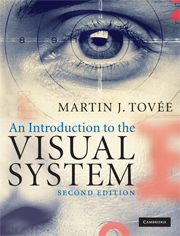Book contents
- Frontmatter
- Contents
- 1 Introduction
- 2 The eye and forming the image
- 3 Retinal colour vision
- 4 The organisation of the visual system
- 5 Primary visual cortex
- 6 Visual development: an activity-dependent process
- 7 Colour constancy
- 8 Object perception and recognition
- 9 Face recognition and interpretation
- 10 Motion perception
- 11 Brain and space
- 12 What is perception?
- References
- Index
- Plate sections
3 - Retinal colour vision
Published online by Cambridge University Press: 05 June 2012
- Frontmatter
- Contents
- 1 Introduction
- 2 The eye and forming the image
- 3 Retinal colour vision
- 4 The organisation of the visual system
- 5 Primary visual cortex
- 6 Visual development: an activity-dependent process
- 7 Colour constancy
- 8 Object perception and recognition
- 9 Face recognition and interpretation
- 10 Motion perception
- 11 Brain and space
- 12 What is perception?
- References
- Index
- Plate sections
Summary
Why do we need more than one cone pigment?
In the vertebrate eye, colour is detected by cone receptors. In the case of humans and other Old World primates, there are three cone classes (Figure 3.1). A blue or short-wavelength pigment absorbing maximally at 420 nm, a green or middle-wavelength pigment absorbing maximally at 530nm and a red or long-wavelength pigment absorbing at 565nm (Dartnall et al., 1983). For an animal to be able to discriminate between colours, it must have two or more different classes of cones. This is because a single cone pigment cannot discriminate between changes in wavelength and changes in the intensity of a light. For example, a red cone will respond strongly to a 560-nm light, but weakly to a 500-nm light. However, the same pattern of response can be obtained by a light of fixed wavelength, say 560 nm, and changing intensity, as a single cone class can only signal the number of photons absorbed by its pigment. This pattern of response is called univariance. To make the crucial differentiation between wavelength and intensity, a comparison of signals from two or more cone classes is required. 540-nm and 640-nm lights will produce different patterns of firing in the red and green cones as compared with two 540-nm lights of different intensity. As a general rule of thumb, the more cone classes in an eye, the better will be the wavelength discrimination.
- Type
- Chapter
- Information
- An Introduction to the Visual System , pp. 44 - 61Publisher: Cambridge University PressPrint publication year: 2008



